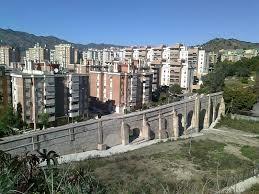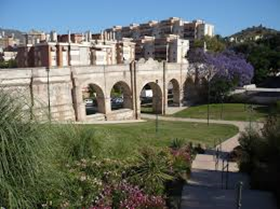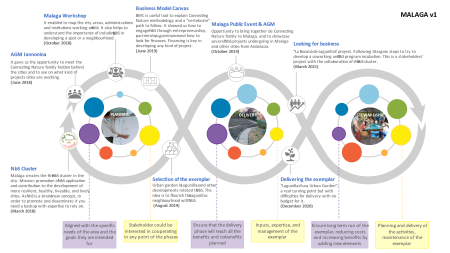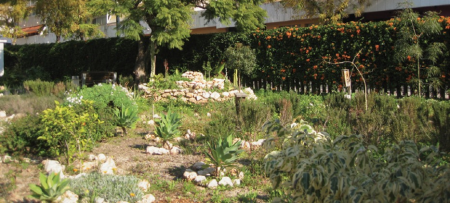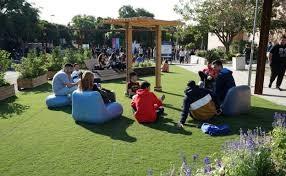
Area characterisation:
Malaga is a Mediterranean city located in the South of Spain, with a green and blue environment typical from the Mediterranean coastal cities. During many years Malaga was mainly known as a touristic destination due to the diversity of its environment offering beaches and mountains landscapes but also because the city has a mild climate throughout the year.
For more than three decades Malaga has been relying on tourism and construction as the main engine of the local economic activity, building hotel and residential developments with little regards to the environment. In the past two decades consciousness about the environment has hit many social actors who have seen the need to evolve the productive model towards one that is more respectful of the environment. Cities are today human ecosystems with the best opportunities for social, economic, and environmental opportunities but at the same time they face important inequalities and some of the biggest sustainability challenges.
The City of Malaga is implementing measures to improve the environment and thus also improve the quality of life of its citizens. The city is exploring ways to restore an ecosystem damaged by the impact of economic activity and through the Connecting Nature project, learn more about the benefits of this framework and its methodology. The city had already developed some nature-based solution but without applying the framework of the Connecting Nature project
This innovative framework involves a series of innovations in the way of facing and implementing nature-based solution projects, introducing new elements such as co-production, co-creation, governance, financial and business models, technical solutions, impact assessment, nature based entreprises and reflective monitoring when creating, planning, executing, and maintaining those projects. The connecting nature framework seeks to optimize environmental, economic, and social resources by applying its own work methodology.
Objective:
The Connecting Nature project in Malaga is part of developing a new perspective for urban planning and in the Lagunillas neighborhood. The implementation of this new perspective can cover the three types of interventions:
The renovation of three public squares in Lagunillas
- The renovation of public squares.
- The development of a green corridor between Lagunillas and the mount Gibralfaro
Finally, the Connecting Nature project in Lagunillas aims for urban revitalization of this dense neighborhood located in the city center.
Our Nature based solution exemplar is to build a nature Based solution urban garden in a disused plot of land in the Lagunillas Neighborhood. Lagunillas has several plots of land abandoned and the idea is to do a pilot project in the area with the possibility in the future to replicate the idea in other plots or in other neighbourhoods.
The Lagunillas neighborhood has very little green spaces but has a lot of walled and abandoned plots. Most of those plots belong to private people and a few of them belong to the city. Private owners are attentive to the development movements of the city council, they are waiting for real estate opportunities that will end up creating gentrification in the area.
The urban garden La Yuca was designed in a participatory process with the partners involved ( OMAU, Cluster NbS). It was then built by some private companies from the Cluster dividing the plot in three parts, one for schools to come and learn about the autochthonous plants in Málaga, the other as a space for the neighbors to gather and relax and the third for elderly neighbors to be able to cultivate some produce doing moderate activity buy also to get together with other people and therefore aimed to fight loneliness.
In this context we also have a population in the area that is also growing older, so the idea is to generate interest among residents and neighbours and to keep them active.
Images
Financing:
Up to date capital expenditure costs are financed by the city hall areas. The city Hall is currently divided into 8 areas. Each one of these areas prepares a Budget with an expense forecast for the following year. There are several different types of expenses depending upon the characteristics of the expense. In the case of connecting nature:
- Infrastructure costs for new investments and developing new activities.
- Public procurement costs to develop new activities or to support existing ones.
- Personal and material costs will be used within other costs to quantify general costs of developing new projects.
- Expertise and evaluating costs as part of the technical costs of developing and maintaining projects.
- Community campaign costs are needed to sensibiliser the population area and to inform on the projects and developments that are going to take place in the area.
- Community works will be at a second stage to see if the project can be run and maintain by the community
- Educational and training costs are needed to carry on the projects with good practices and knowledge on what needs to be done.
OMAU is the overall coordinating body for this process; other partners include CIEDES (indicators), other partners such as Promalaga, OMAU submits projects to city hall for funding. City Hall can ask OMAU to develop projects and OMAU can submit suggestions for funding independent projects funded by city from own funds (City fiscal budget, taxes etc) comes through city planning (feasibility) environment, tourism etc depending on purpose of project.
It is important to say that within the country there are several layers of financing available depending on the type of project, the site of the project and the relevance of the project. In case of capital expenditure local City Hall get support from regional and national government, European funds and sometimes in the case of a public and private cooperation mixed funds.
Local funds usually are given to the municipality departments to develop projects but in the case of NbS of green and blue infrastructures like parks and beaches the amount can be divides in expenses in materials, maintenance, and investments.
Regional funds: are usually reserved to develop bigger projects in the cities like the Green Ring or the Climate Plan. Several actions can be mixed budget between regional and local governments.
National Funds: Usually used for bigger infrastructures and for building o renovate public spaces.
Private funds: in Spain, this modality is very rare unless it is made through a public and private partnership
Potential impacts/benefits:
Malaga’s exemplar should achieve many goals, but it is important to say that the development of the exemplar should lead to open new ways of implementing and doing things.
So far, we can aim at the following objectives:
- Promote Nature based solutions within the city. This is an important aspect since NbS is a brand-new concept here. To do so we should work on the gated and abandoned plots by transforming them into productive plots aimed towards social use, social cohesion, and activity promotion.
- Promote NbS Cluster. The Malaga Nature Based Solutions cluster was created in 2018 to exchange knowledge, raise opportunities and disseminate Nature based solutions. It started with 8 companies and has grown up to 30 companies all related to gardening, laws, protection of nature, topography, solutions for cities, and environmental companies.
- New development of Lagunillas. The Lagunillas neighborhood has little green, a lot of concrete and many empty plots walled so people do not get in them. It is important in the development of Lagunillas to create more green spaces and to connect them with the nearby hills of Gibralfaro.
- Reintroduction of autochthonous plants. This aspect has been an issue for a long time. In Malaga there are a lot of invasive species (Pampa’s duster, eucalyptus, reed beds, acacia, cat's claw), brought in the past by foreigners. These species have been in certain cases very invasive, and it is now time to replace them by the autochthonous ones.
- Develop economic activities and initiatives in the area. To do so you need to plan solutions that will attract business to the area. This is a challenge since the economic development of an area usually also generates important problems like gentrification. Economic initiatives like the incubator project can help to provide the area with new businesses.
- Provide a space for education. It is important to promote educational activities and it is important to do so with young people, to teach them the importance of nature as itself but also to promote the importance of nature in the health and wellbeing of the people, to ensure good practices in the future.
- Promote neighborhood activities by creating spaces for the community. In this case urban gardening can be a moderate activity for the neighbours to ensure some social contact, gain in wellbeing and fight loneliness.
- Increase social cohesion among the community and within the neighborhood by promoting relationships among neighbours and helping develop social skills of people in situations of vulnerability and loneliness
- Promote models of active citizenship, increasing engagement, community self-organization and involvement in social life. Engage citizens to play an active role in the maintenance and managing of the public space.
Actions:
The Connecting Nature project in Malaga is part of developing a new perspective for urban planning and in the Lagunillas neighborhood. The implementation of this new perspective can cover the three types of interventions:
The renovation of three public squares in Lagunillas
- The renovation of public squares.
- The development of a green corridor between Lagunillas and the mount Gibralfaro
- Finally, the Connecting Nature project in Lagunillas aims for urban revitalization of this dense neighborhood located in the city center.
Our Nature based solution exemplar is to build a nature Based solution urban garden in a disused plot of land in the Lagunillas Neighborhood. Lagunillas has several plots of land abandoned and the idea is to do a pilot project in the area with the possibility in the future to replicate the idea in other plots or in other neighbourhoods.
The Lagunillas neighborhood has very little green spaces but has a lot of walled and abandoned plots. Most of those plots belong to private people and a few of them belong to the city. Private owners are attentive to the development movements of the city council, they are waiting for real estate opportunities that will end up creating gentrification in the area.
The urban garden La Yuca was designed in a participatory process with the partners involved ( OMAU, Cluster NbS). It was then built by some private companies from the Cluster dividing the plot in three parts, one for schools to come and learn about the autochthonous plants in Málaga, the other as a space for the neighbors to gather and relax and the third for elderly neighbors to be able to cultivate some produce doing moderate activity buy also to get together with other people and therefore aimed to fight loneliness.
In this context we also have a population in the area that is also growing older, so the idea is to generate interest among residents and neighbours and to keep them active.
Organisations:
- City of Malaga – Environmental and Urban Planning departments – Environmental department will have a central role in the design and possible implementation of the Nature based solution. Urban planning is important for land use and land management.
- IUCN Mediterranean (headquarters for the Mediterranean area are in Malaga) instrumental in establishing a NbS cluster in Malaga – can provide expertise and guidance on optimum Nature based solutions for the rea. The person in charge is Andrés Alcantara
- University of Malaga – Also a founding partner of the NbS Cluster. Experience in implementing NbS and can provide expertise in environmental monitoring. The Uma through its area of Smart-Campus (directed by Raquel Barco Moreno) has developed the green island project aiming at giving extra green spaces and shades to students on Campus.
- Nature Base Solution Cluster. With a mix of private and public companies from different activity sectors it could provide expertise and resources to the development of Lagunillas.
- BioAzul is a company with experience in Nature based solutions and could provide expertise
From a social perspective the following partners have been identified:
- Rizoma – NGO active in Malaga currently conducting a needs analysis of the community in Lagunillas.Expertise in community development, skills facilitation, and capacity building.
- Any other NGO’s, community groups, residents, and neighbours (Association Fantasia, association neighbours of Lagunillas, Association Lagunillas Cruz Verde, Association Lagunillas Por Venir
- Local health centre to measure the impact on health.
- Local and elected politicians from the districts that usually are aware of the problems first hand from the neighbours.
From an economic perspective the following partners have been identified:
- Local businesses – repair shops, local tavernas, craft shops etc (Association of businessman of Lagunillas)
- Chamber of commerce
- Local Co-ops
- Social enterprises active in the area
- Enterprise support agency
- Corporate and social responsibility departments of Banks like Triodos Bank or La Caixa.
Other partner who needs to be invited include:
- OMAU – projects broker, collaborate with City and Promalaga to identify, source funding and implement projects
- CIEDES Foundation – strategic development role.
- Promalaga which is the Malaga local development agency.
Global goals:
-
3. Good Health and well being
-
4. Quality education
-
10. Reduced inequalities
-
11. Sustainable cities and communities
-
17. Partnerships for the goals
NBS goals:
- Enhancing sustainable urbanization
- Urban regeneration through nature-based solutions
- Nature-based solutions for improving well-being in urban areas
NBS benefits:
- Enhancing sustainable urbanisation
